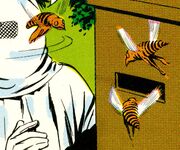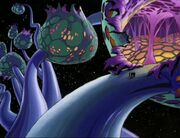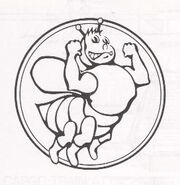
Large bee species from Njura
A bee or honeybee is a type of lifeform, a flying insect animal native to the planet Earth as well as other planets. Their body produces from its glands and plant pollen the edible, semi-solid honey.
These creatures built intricate hives, yet were not intelligent. Hymenoptera Apis mellifera was a common variety. (TOS novels: Vulcan!, Yesterday's Son)
They made hives from beeswax and pollinated plants. Someone who managed bee colonies was called a beekeeper. Starfleet workbees were named for the insects.
History and specifics[]
Honeybees fertilized the grapes at Jean-Luc Picard's vineyard, Château Picard, in La Barre, France. (TNG - The Q Continuum novel: Q-Strike)
In the late 21st century, honeybees, along with basil, clover, sage, fennel, tomatoes, strawberries and farm crops, were brought to the first L-5 Earth space station. The bees were kept in farms established along the inside walls of the vessel's cylindrical hull. The station eventually became known as the generational ship Wanderer. (TOS novel: The Galactic Whirlpool)
In the 23rd century, bees were imported to pollinate vegetables on Proxima Beta. (TOS - Fortunes of War novel: Dreadnought!)
In the year 2239, Leonard McCoy sat on a bee during a picnic at Sunday school. He confessed to never having been a beekeeper. (TOS novel: Yesterday's Son)
In 2254, McCoy and Elizabeth March had an outdoor sexual activity interrupted by a bee on Nova Empyrea. (TOS novel: The Better Man)
In 2268, the speech of Scalosians to the unaided ear were mistaken for that of bee wings rapidly buzzing. This distortion effect was from their existence in an accelerated, subspace domain. (TOS episode: "Wink of an Eye")

Honeycomb structure within the vessel orbiting Questar M-17.
In 2269, a landing party explored the ancient starship orbiting the dead sun Questar M-17. Spock observed that the insectoid pod ship was designed with honeycomb patterns much the way Terran bee drones structured their hives. (TAS episode & Log One novelization: Beyond the Farthest Star)
In 2270, Njuran President and beekeeper Kring crossbred a variety of bee on the planet Njura which was about 6" long and produced a pink honey called varta. It had a very painful stinger capable of injecting deadly poison into the bloodstream. (TOS comic: "To Err Is Vulcan")
In 2270, the USS Enterprise was ordered to transport an experimental variety of honeybee from Starbase 11 to the planet Sirena on the far side of the sector. Spock described the habits and life of honeybees to his son Zar, who had never heard of them on Sarpeidon. (TOS novel: Yesterday's Son)
Comments[]
In 2267, Spock told James T. Kirk that the "birds and bees" were not Vulcan in regards to his pon farr, in reference to an ancient Human language idiom using such a reference regarding biology. (TOS episode: "Amok Time")
In 2275, on Nova Empyrea, Montgomery Scott suggested that angry people had a bee "in their bonnet". (TOS novel: The Better Man)
In 2375, after a sexual encounter with Derran Tal, Harry Kim commented on how differently their species mated. He said to her that "the birds and the bees would be very confused." (VOY episode: "The Disease")
Appendices[]
Images[]
Appearances[]
References[]
- TOS episode: "Amok Time"
- TOS episode: "Operation -- Annihilate!"
- TOS episode: "Wink of an Eye"
- TAS episode & Log One novelization: Beyond the Farthest Star
- TNG episode: "A Fistful of Datas"
- ENT episode: "Shockwave"
- VOY episode: "The Disease"
- TOS novel: The Better Man
- TOS novel: Yesterday's Son
- TOS novel: Dreadnought!
- TNG - The Q Continuum novel: Q-Strike
- TNG - A Time to... novel: A Time to Be Born
- TNG - The Dominion War novel: Tunnel Through the Stars
External links[]
- Bee article at Memory Alpha, the wiki for canon Star Trek.
- Bee article at Wikipedia, the free encyclopedia.

